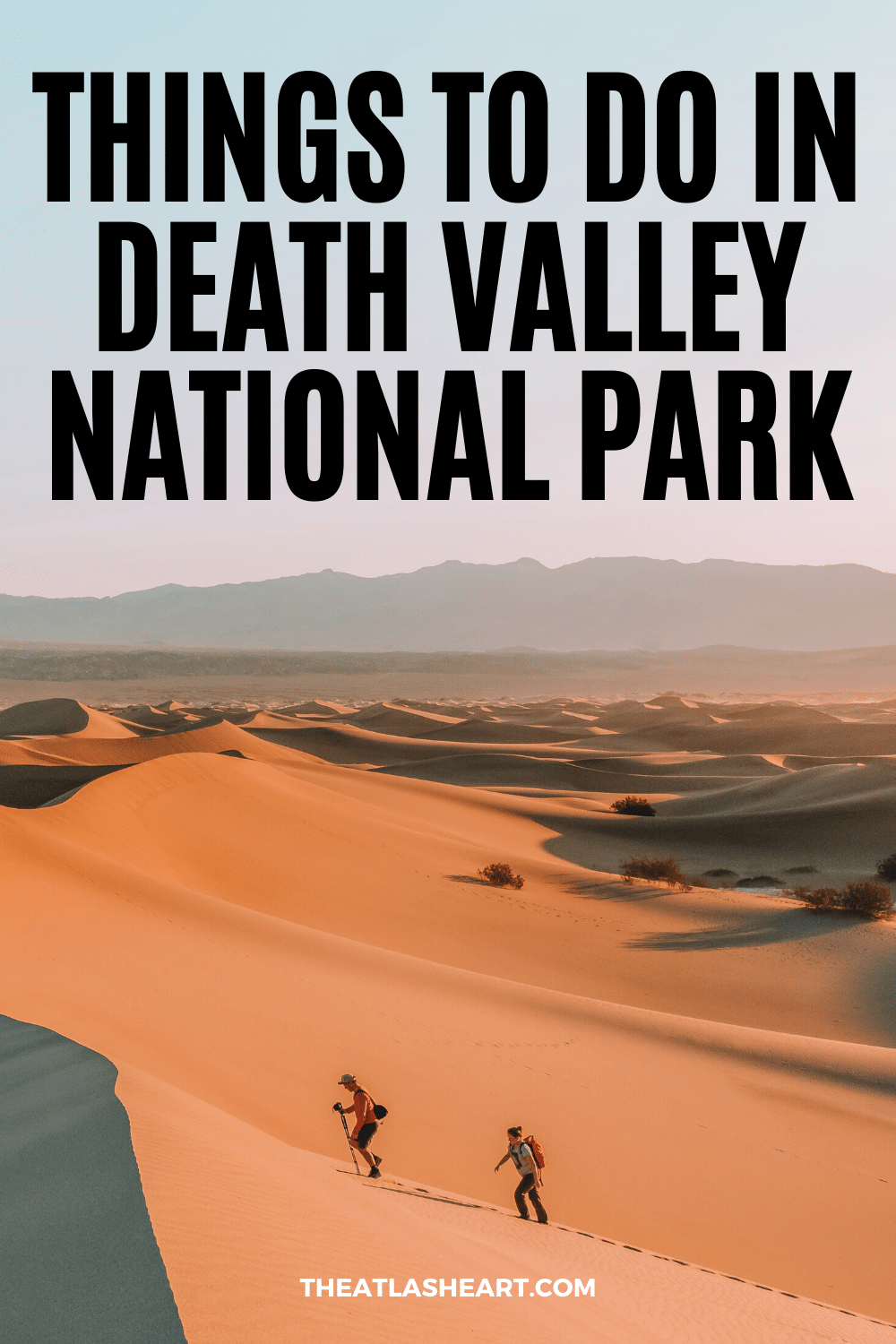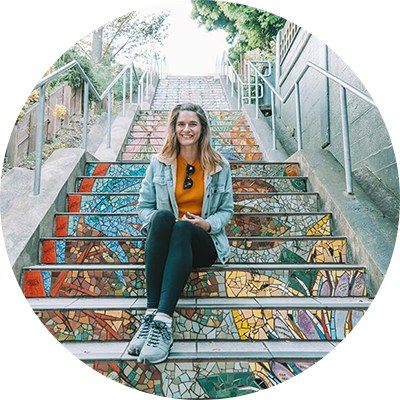TL;DR: With so many options, the best things to do in Death Valley National Park are visiting viewpoints like Dante’s View, renting Jeeps to see the magical moving rocks at Racetrack Playa, and searching for adorable wild burros. Here’s a quick overview:
- Badwater Basin, Zabriskie Point, Dante’s View, and Artist’s Palette offer iconic scenery and views in the park.
- When temperatures soar, head to higher elevations at Dante’s View, Scotty’s Castle, or the Racetrack Playa to find relief from the heat.
- Spotting wild burros, dining at The Ranch restaurant, staying at the historic Inn, and stargazing are beloved local activities.
I’ve been exploring the California national parks for several years now and Death Valley is one of my favorites due to its unique nature and otherworldly landscapes.
Although it might just look like an extreme desert wasteland at first glance, there are tons of things to do in Death Valley National Park.
The largest national park of the lower 48 offers a lot of variety.
Of course, you shouldn’t miss the top must-sees, but have you ever explored an old ghost town where miners used to live?
Or what about hiking at 11,000 feet in cool weather while looking down at one of the hottest places on earth?
From the best hikes in Death Valley to the most unusual things to do at the park, get ready to plan the desert trip of a lifetime with this post.
Note: this article contains affiliate links, which help run this site at no extra cost to you so I can keep providing free travel advice and tips.
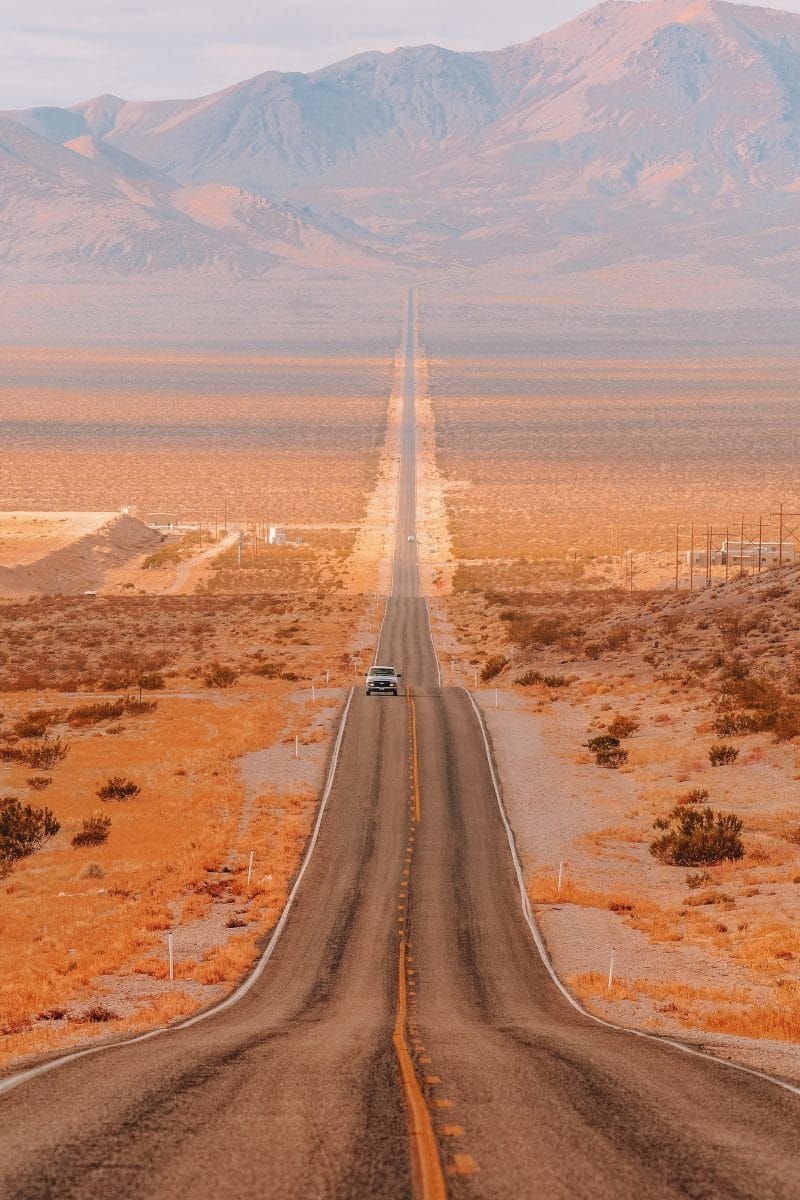
Map of Things to do in Death Valley National Park
Get your FREE California Travel Planner – including printable checklists and my favorite two-week itinerary for the state.
Best Things to do in Death Valley National Park
Stroll Across Badwater Basin
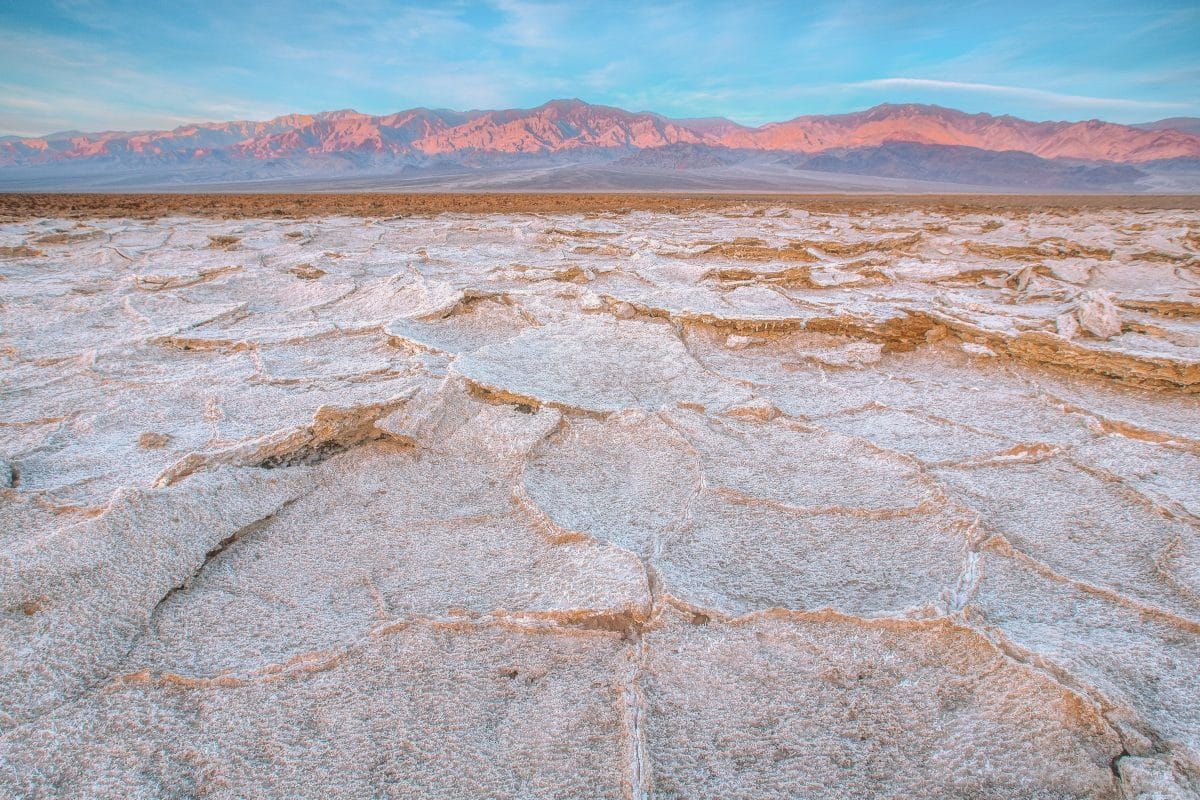
Among the top things to do in Death Valley National Park is Badwater Basin. At 282 feet below sea level, this is the lowest point in North America.
Badwater Basin is so low because a fault line runs through Death Valley that makes the valley floor drop.
And it’s a place that’s true to its name; the “bad water” that comes out of the ground here is full of minerals and contains more salt than the ocean.
It goes without saying, but drinking the water at Badwater Basin is not one of the recommended activities in Death Valley National Park.
When you visit Badwater Basin, turn around and look at the rock wall behind you; the National Park Service has a sign that shows where the sea level is located, far above your head.
Before you leave, walk over the salt flats and bask in the heat of the valley floor.
The salt flats are also where you can experience the juxtaposition of looking across the warm valley to Telescope Peak, the highest point in Death Valley that’s often covered in snow.
Hike to a Natural Bridge

Just up the road from Badwater Basin, there’s a turn-off to a dirt road on the right that leads to a parking area at the foot of the mountains.
From the parking area, you can go for a short hike into the canyon. After only half a mile of easy hiking in the wash, you’ll get to a natural bridge that spans the narrow canyon.
Yes, it’s completely natural! The Natural Bridge was carved out of the rock by water and wind. It “just” took thousands of years, but the result is stunning.
From there, you can either turn around and return to the parking lot or keep hiking up the canyon as far as you like.
Play at the Devils Golf Course
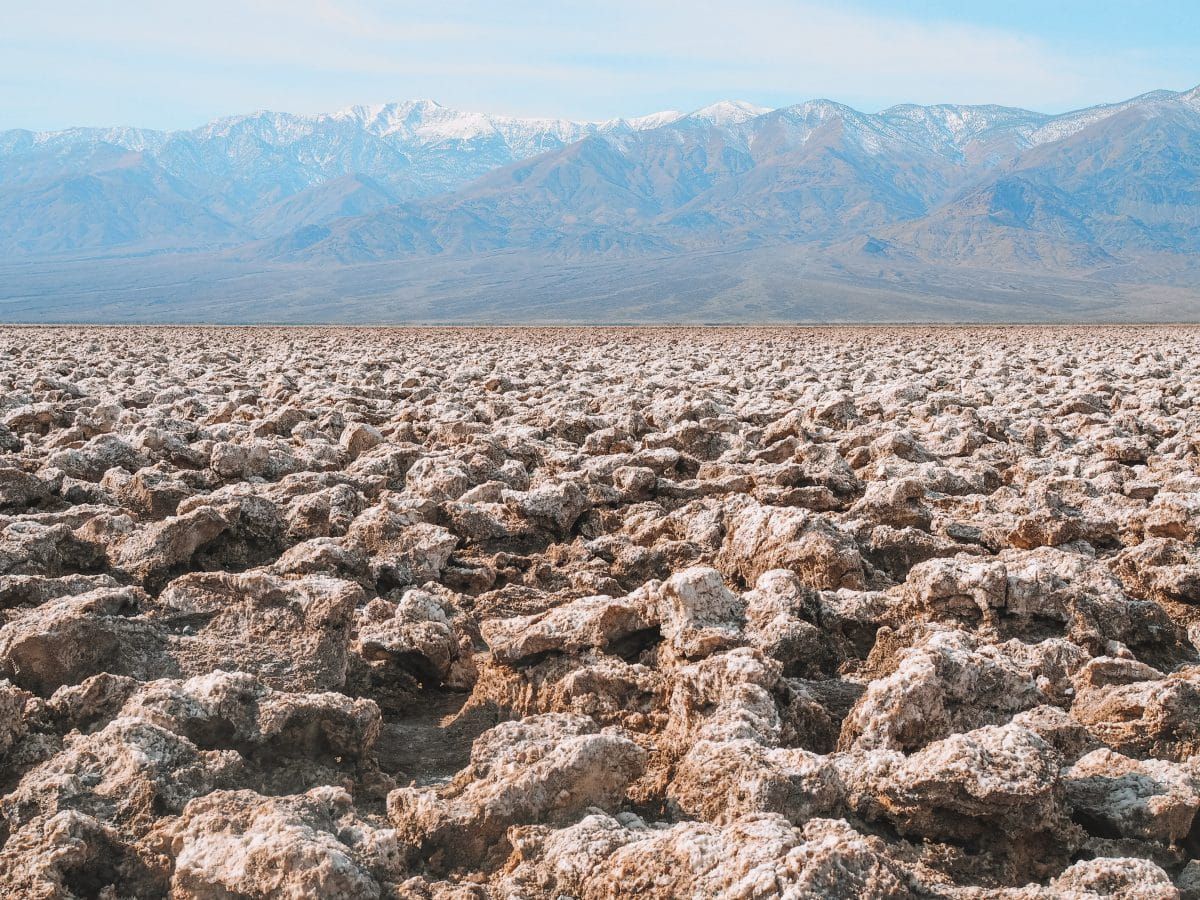
Okay, so this isn’t an actual golf course but another part of the salt flats that make up Badwater Basin.
Here, the salt and minerals create different shapes than at the main Badwater Basin area.
At Devils Golf Course, you’re still 277 feet below sea level (aka almost at the same elevation as the lowest point of Death Valley National Park).
Explore the razor-sharp edges of the salt formations and see for yourself why the first explorers gave this place the name they did.
I mean, can you imagine taking a wagon across these salt flats?
Visiting this place is one of the best things to do in Death Valley that never gets boring. Once you start looking closer, you’ll notice how every salt formation is slightly different from the one next to it.
Additionally, throughout the day the light changes its angle and the look of Devils Golf Course with it.
The road from Badwater Road to Devils Golf Course is unpaved but passable for all types of cars unless it just rained.
Admire the Artist’s Palette
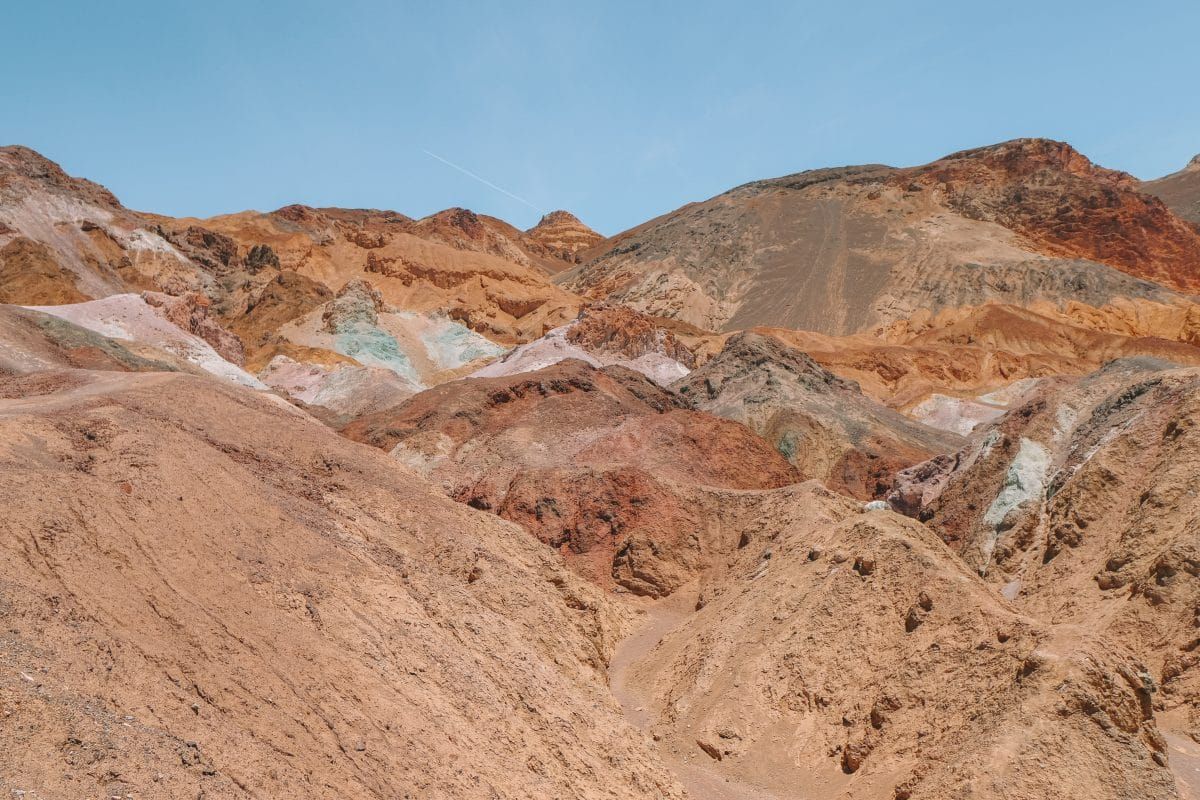
If you continue your road trip from Badwater Basin to the north of the park, you’ll come to a small road that leads to Artist’s Drive.
This road is paved and accessible year-round and leads to several parking areas where you can walk to the nearby Artist’s Palette.
This accumulation of sedimentary rocks contains so many different colors it resembles an actual artist’s palette.
Take your time to enjoy the area’s various viewpoints and stop at any of the parking lots along Artist’s Drive to wander around.
By the way, if you like road biking in unusual places, you should bring your bike and add the Artist’s Drive to your bucket list.
Since it’s a winding one-way road with a low speed limit, you can take your time here and enjoy a bike ride without cars zipping by at high speeds.
Not to mention, the Artist’s Drive was freshly paved not too long ago which makes the ride smooth and enjoyable.
Local tip: The Artist’s Drive is a one-way road, so make sure you’re following the signs.
Enjoy a True Oasis at Furnace Creek

Furnace Creek is a true oasis in the valley. The village wouldn’t exist if it wasn’t for the small amount of water that comes out of the ground in the area.
The village of Furnace Creek is the main hub and one of the top things to see in Death Valley National Park, just don’t expect a big city – you’re still in the remote desert.
One of my favorite things to do there is to take a short stroll into the hills above the village and watch the sunset from higher up.
Sometimes you can even watch coyotes roaming the area below.
Off to the south of Furnace Creek is a small reservation where the members of the Timbisha Shoshone tribe have lived for many generations.
See One of the World’s Most Famous Thermometers
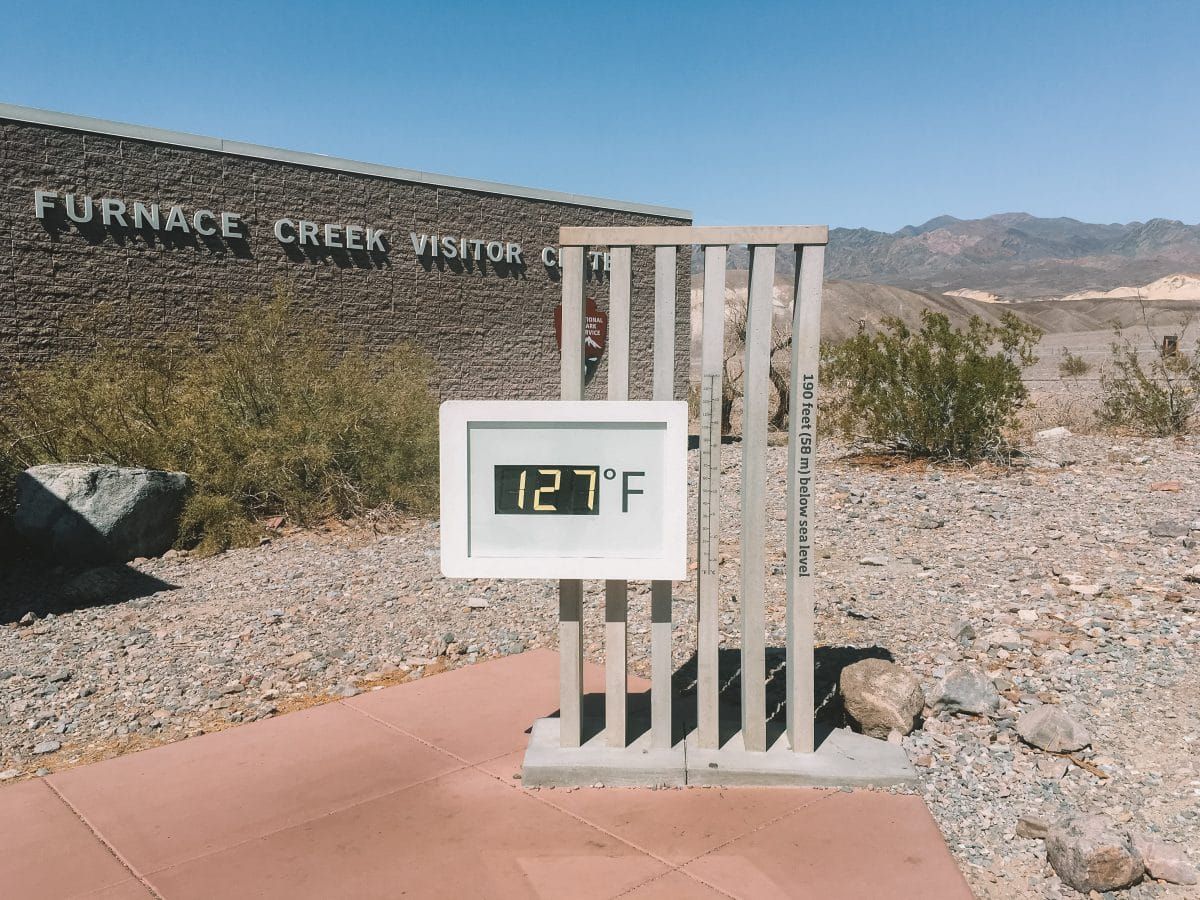
Yes, I’m really sending you to the Death Valley National Park visitor center to check out a thermometer.
Before you skip this section, hear me out: this is the thermometer, where the world’s highest temperatures get recorded every summer.
If you’re looking for things to do in Death Valley in summer, you should visit the thermometer to have a look at how the scorching heat gets displayed in numbers.
Fun fact: Did you know that shoe soles can melt during summer in Death Valley National Park? If it’s really hot, you can see for yourself.
Go Back in Time at Harmony Borax Works
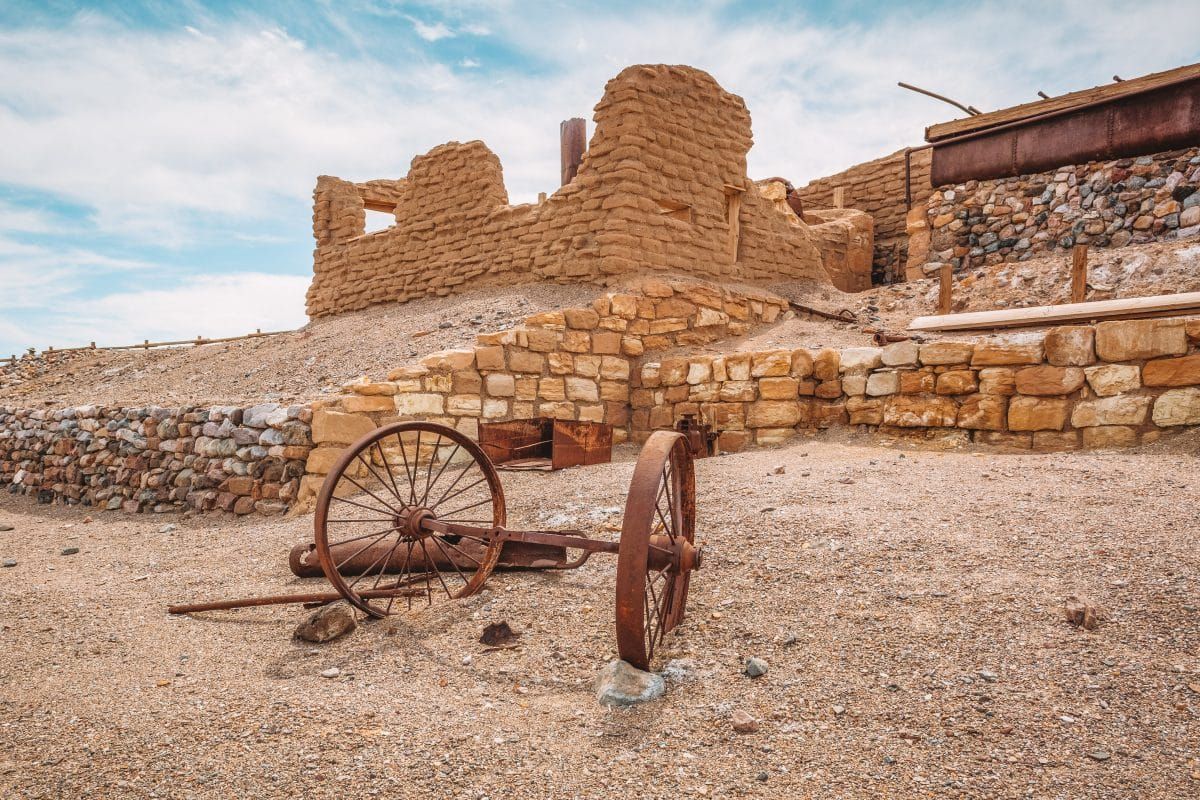
Borax was just one of many minerals that were mined in Death Valley National Park, long before it became a national park.
The Harmony Borax Works is conveniently located just north of Furnace Creek and well worth a visit.
One of the highlights at Harmony Borax Works is the wagon of the Twenty Mule Team.
Many years ago, miners used to transport the borax via wagons to the town of Mojave, where the nearest train station was located.
Instead of using horses, they bred donkeys with horses to create mules since they have much better footing in rugged terrain.
Today, one of these double-wagons is reconstructed and on display at the Harmony Borax Works.
To this day, there is a borax brand called “Twenty Mule Team,” which you can find at national brand name stores like Target and Walmart.
Local tip: If you stay at Furnace Creek and have a bike, take the new bike trail from the village to the borax works.
Revive Your Inner Child at Mesquite Flat Sand Dunes
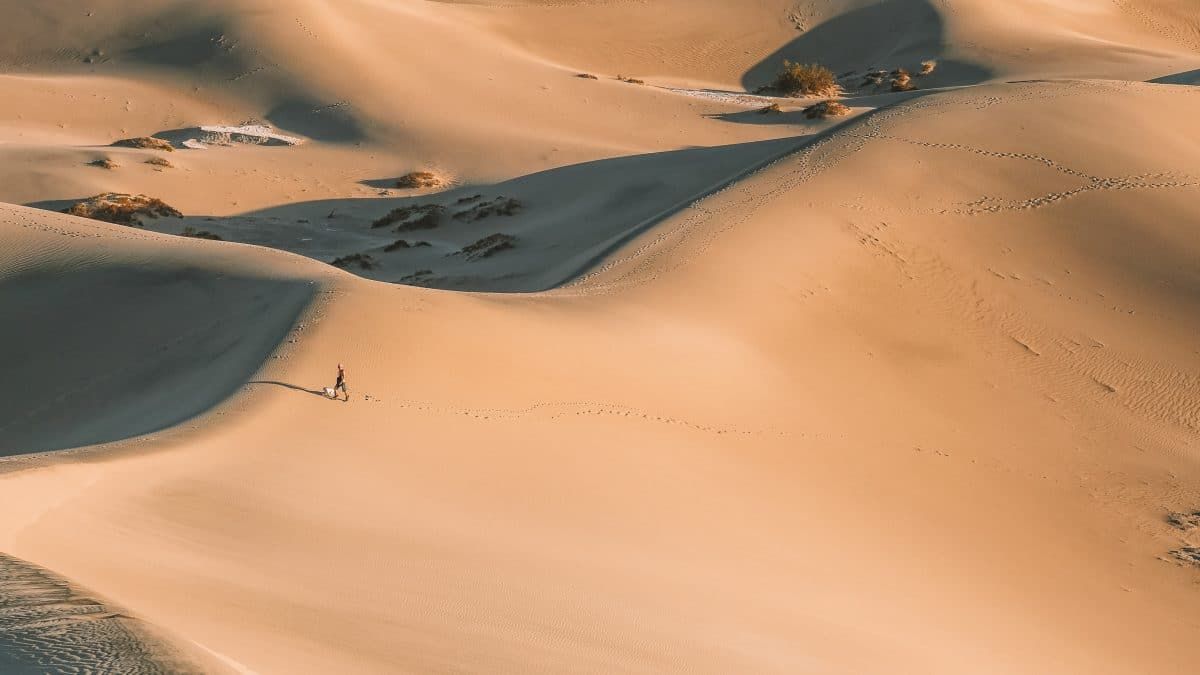
When you follow Highway 190 from Furnace Creek towards Lone Pine and US Highway 395, you’ll pass sand dunes on your left, just a few miles before reaching Stovepipe Wells.
These are the Mesquite Flat Sand Dunes.
Leave your car at the designated parking lot (you won’t believe how many people think they can drive onto the sand).
From there, wander into the surreal landscape made entirely of sand.
Run in the sand, slide down the steep side of the sand dunes, or simply sit on top and enjoy the views of the huge valley below you.
By the way, this is a wonderful spot for sunset or sunrise, just make sure you bring a headlamp so you don’t get lost in the dark.
Enjoy the Views at Zabriskie Point
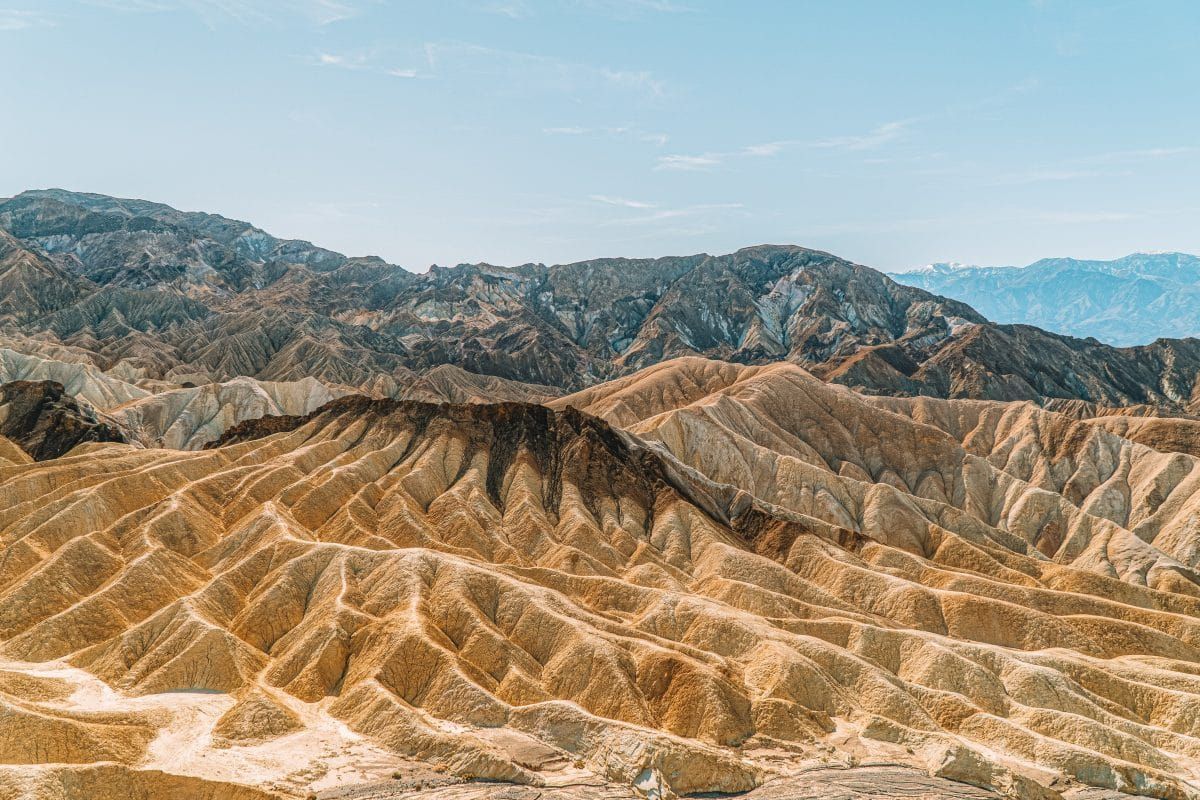
Not far from Furnace Creek, you’ll find Zabriskie Point. This viewpoint is either accessible by walking 0.6 miles from the top or via a short 1.7-mile hike through Golden Canyon.
If you decide to take the hike, you’ll pass through a fairly narrow canyon with golden walls on your way up to the Zabriskie Point.
Once you reach the top, you’ll be rewarded with a breathtaking view of the colorful rock formations in front of you.
Enjoy Even More Majestic Views at Dante’s View
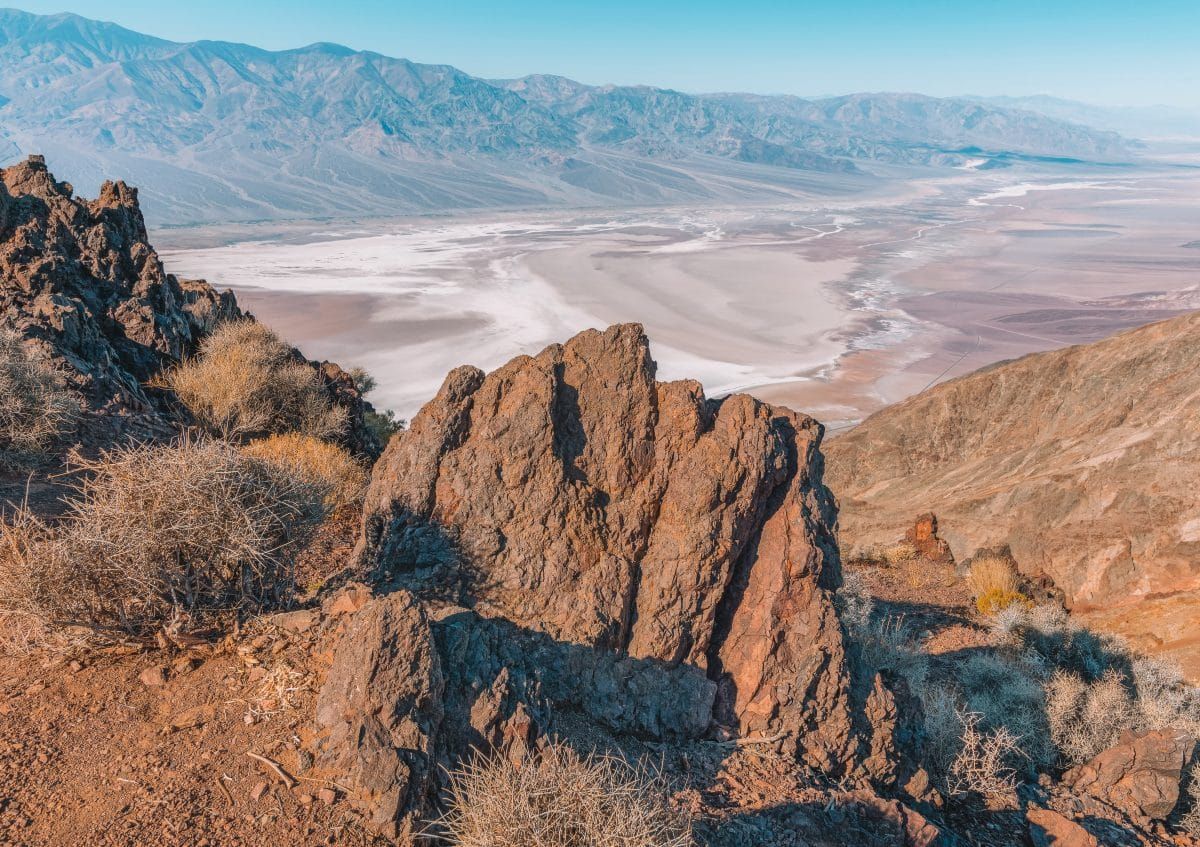
Taking a drive up to Dante’s View and spending time admiring the scenery from the top is one of my favorite things to do in Death Valley.
If you’re entering the national park on Highway 190 from the direction of Las Vegas, this could be one of your first stops.
You’ll find a turn-off on your left that leads to Dante’s View, just note that the last 5.5 miles of the 21-mile journey are steep and increasingly winding.
In the end, it’s worth the hassle when you stand at Dante’s View, towering almost 6,000 feet above Badwater Basin.
And due to its elevation, Dante’s View is still a great place to visit in Death Valley during the hottest time of the year.
Take a Hike in Mosaic Canyon
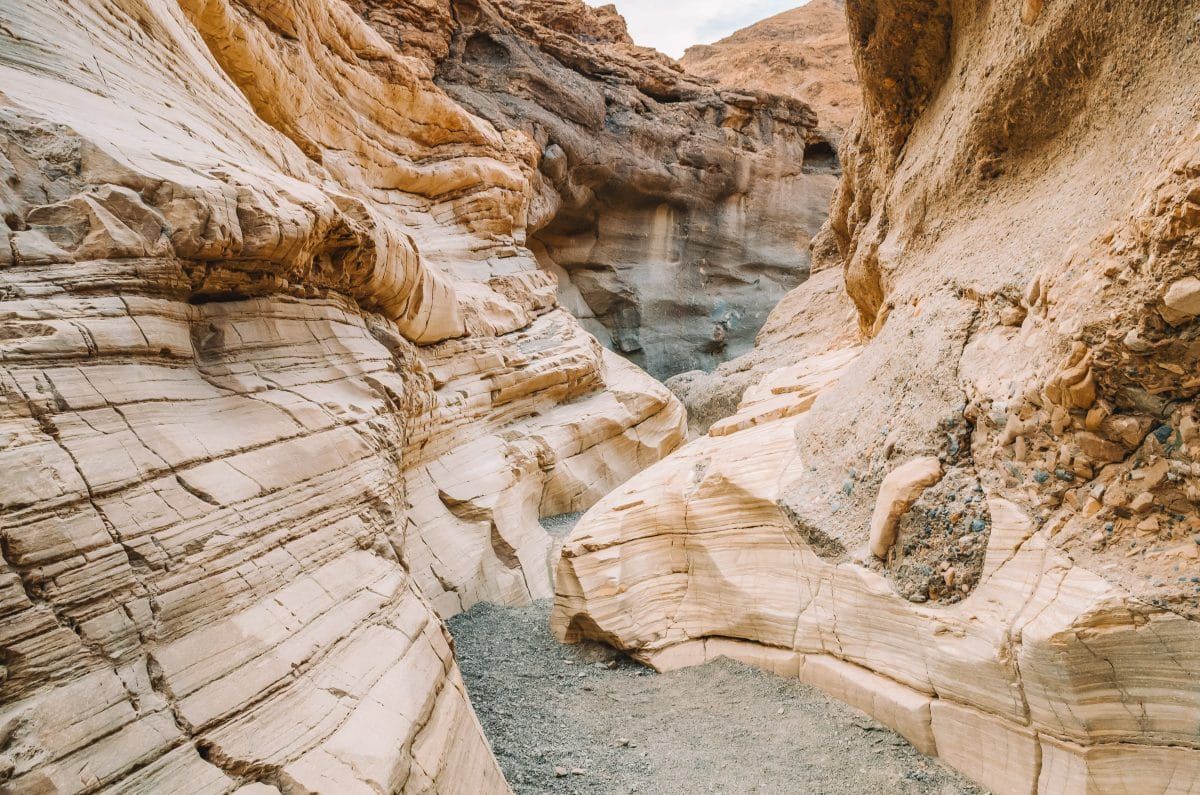
Among all the hikes in Death Valley, this is one of my favorites.
Access the Mosaic Canyon via a dirt road that starts near Stovepipe Wells. Usually, the road is pretty passable and you don’t need a high clearance vehicle.
Once you reach the parking area, walk into the canyon that opens up in front of you.
You can go up to 2.3 miles one way before an impassable cliff stops you from going further (at least without technical climbing gear).
Initially, the route is moderate but it gets increasingly difficult as you have to bypass a boulder jam and some dry falls on the last half mile.
The National Park Service offers a GPX-file online, which you can download and import into a map app on your phone.
I just recommend wearing sturdy hiking boots, as the canyon is full of rocks that are just waiting to twist your ankle.
Add Scotty’s Castle to your Bucket List
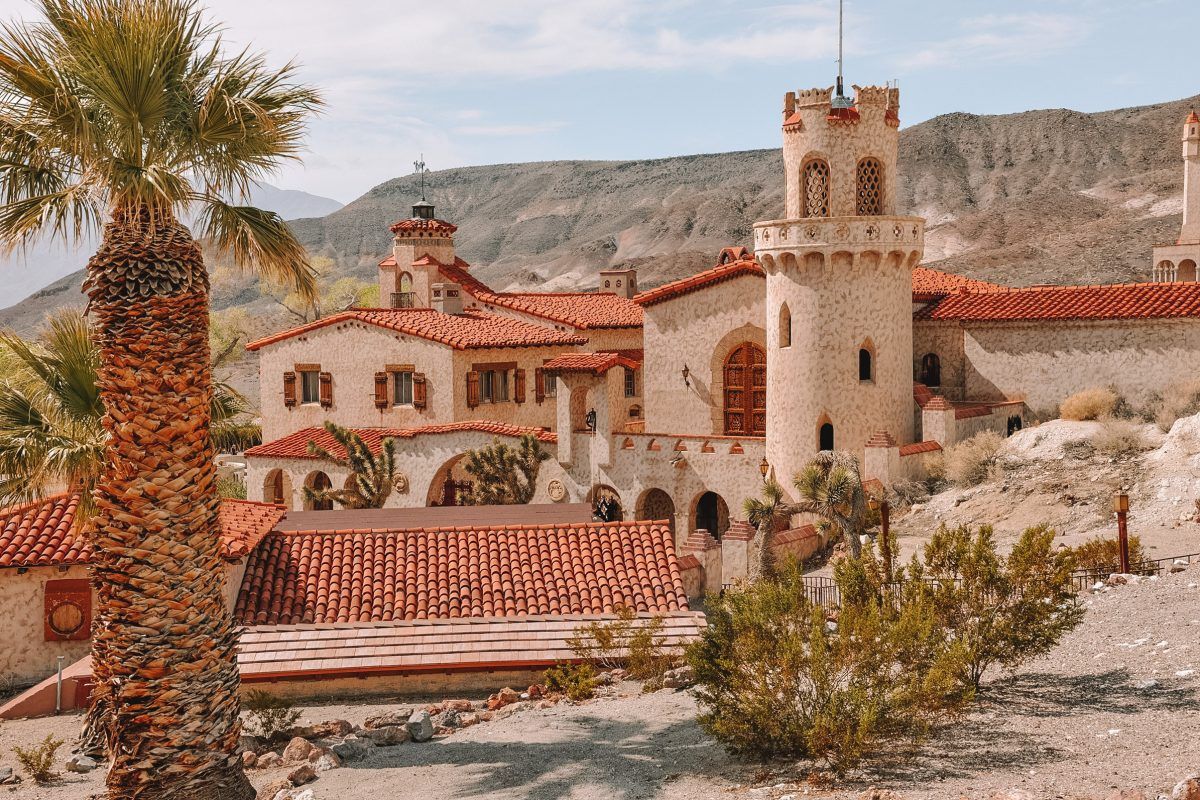
Located in the mountains to the east of Ubehebe Crater, you’ll find Scotty’s Castle.
This villa was formerly owned by Albert Mussey Johnson, a very wealthy man who wanted a personal desert retreat. Today, it’s a Death Valley must-see.
Unfortunately, a flash flood in 2015 took out most of the road in the canyon and flooded the villa with mud.
Since then, repairs have been ongoing and the opening date keeps getting delayed year after year, so it’s an attraction to add to your bucket list for a future visit.
You can check on the NPS website for current updates about Scotty’s Castle.
Unique Things to do in Death Valley National Park
Experience Real Heat
There aren’t many things to do in Death Valley in summer but experiencing the park’s extreme heat is one of them.
Furnace Creek once broke the world record for the hottest place on earth when the thermometer reached 134 degrees Fahrenheit on July 10, 1913.
On summer days, the mercury often climbs to 125 degrees or even higher.
After experiencing that kind of heat, you won’t be complaining about temperatures in the 90s. They’ll feel chilly compared to Death Valley in the summer.
Local tip: If you’re visiting Death Valley during its warmest months, make sure to stay cool and hydrated – heatstroke is a very real and dangerous thing! It’s best to not leave your car for more than a few minutes at a time and hikes aren’t recommended.
Wander Along the Rim of Ubehebe Crater
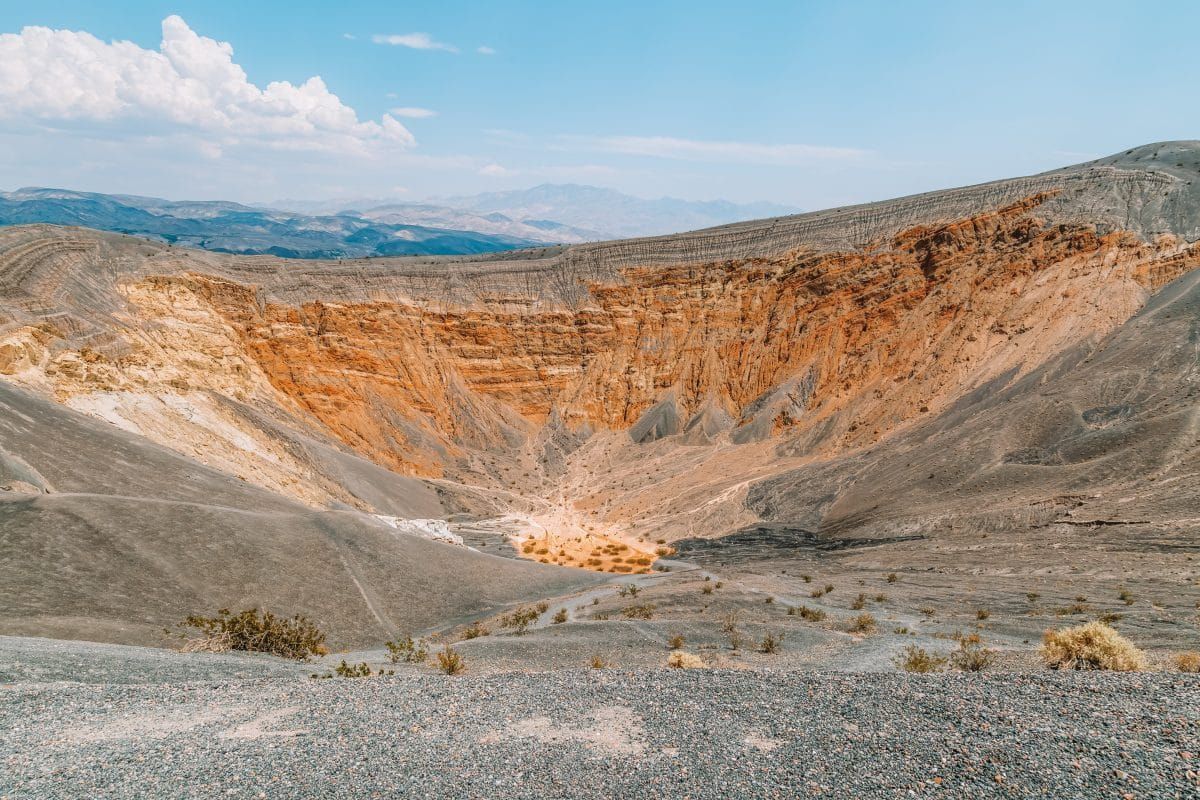
Taking a hike on a volcanic crater is another one of the more unusual things to do in Death Valley.
Not far from Mesquite Sand Dunes, you’ll see Ubehebe Crater from many miles across the valley floor as you drive there.
From the parking area, you’ll have a couple of choices for your hike: you can either take a moderate 1.5-mile loop around the rim or descend straight into the pit of Ubehebe Crater.
The latter hike is just a quarter-mile short but very steep – just don’t forget that you have to go back up it to exit the crater.
You can also take a short side trail from the rim hike to visit Little Hebe Crater, a mini volcano right next to the bigger one.
Visit the Mysterious Rocks at Racetrack Playa
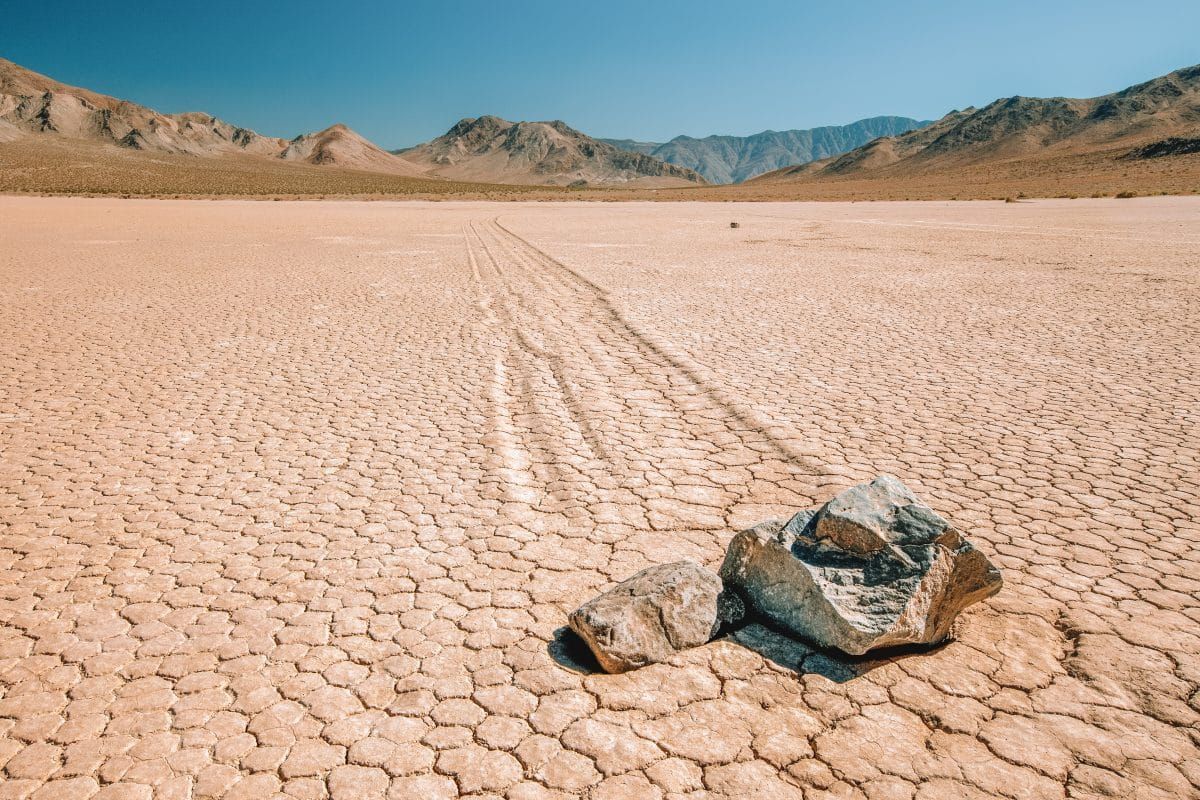
You’ve probably heard of the mysterious rocks at Death Valley that move, seemingly all by themselves, leaving a trail in the dry mud.
Racetrack Playa is where you can see this weird phenomenon for yourself.
It takes a high clearance vehicle to get there, but don’t worry if you don’t have one. You can rent Jeeps next to Death Valley National Park’s visitor center.
If you visit, bring a lot of water, this is one of the most remote locations in the national park.
Although there are still unsolved questions about why these rocks move across Racetrack Playa, scientists have concluded that the whole process is natural.
Sorry, fans of Area 51, the aliens didn’t make a short trip over here. Yet…
Another reason to visit Racetrack Playa is that it reaches 4,000 feet in elevation. When it’s too hot to have fun in Death Valley proper, you’ll find some lower temperatures here.
Spot Some Wild Burros
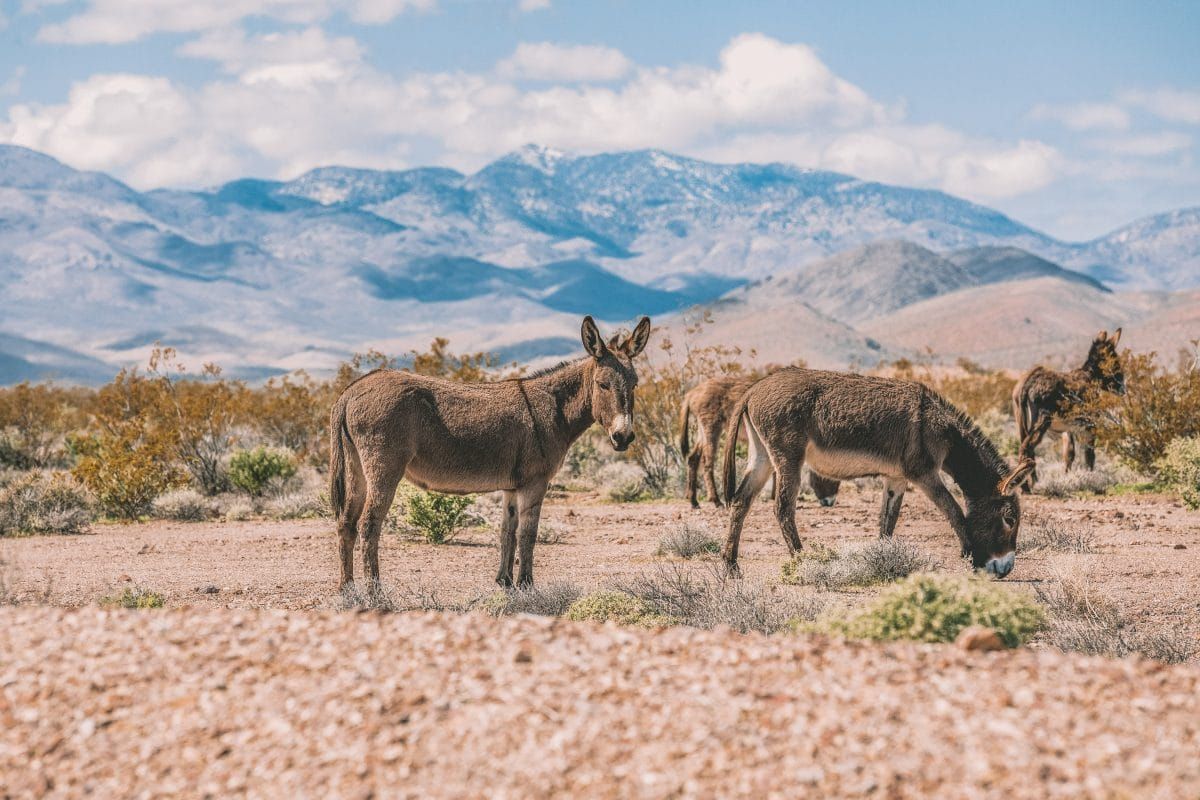
Have you ever seen cute donkeys in the wild? These feral animals are one of my favorite parts of Death Valley National Park.
To the miners back in the day, the horses were seen as useful animals for riding, but the donkeys just wasted room in corrals. This is why they started letting the donkeys roam free.
Quickly, a few donkeys here and there turned into several herds that became spread all over what is now the national park.
Today, the donkeys are part of the local “wildlife” and can be seen around several areas, such as Wildrose Canyon or near the sand dunes in Panamint Valley.
But please don’t feed or pet them! The wilderness provides them with plenty of food and I’ve watched several burros chase visitors who got too close for comfort.
Hike to a Waterfall in the Desert

If you have a little extra time or you’re staying in Panamint Springs, you shouldn’t miss out on one of the best things to do near Death Valley.
Although still in the national park, Darwin Falls is in the second mountain range away from Death Valley.
The road to get to the falls is unpaved but short and usually accessible in any type of car. Hike a mile up the canyon to a waterfall that flows all year long.
Just please don’t swim in the pool at Darwin Falls. I’ve been tempted before and understand the need to cool off but this is a very fragile ecosystem that deserves our protection.
For the hike to Darwin Falls, I recommend sturdy shoes and hiking poles for making your way through shrubs and vegetation.
Enjoy the Desert’s Silence at the Panamint Dunes
Even though the Mesquite Flat Sand Dunes are more famous, they’re not the only ones in Death Valley National Park.
Panamint Valley is another location where you can find beautiful sand dunes and it’s much less visited.
To get to the Panamint Dunes, take the only road that leads north of the highway in Panamint Valley and drive until you reach a small parking lot.
Hike to any place around or in the dunes. There’s no marked hiking trail, just walk around the few shrubs that can withstand the climate.
Sit on top of the dunes, take in the view of the valley and the oasis of Panamint Springs, and enjoy the complete silence.
Visit Star Wars Filming Locations
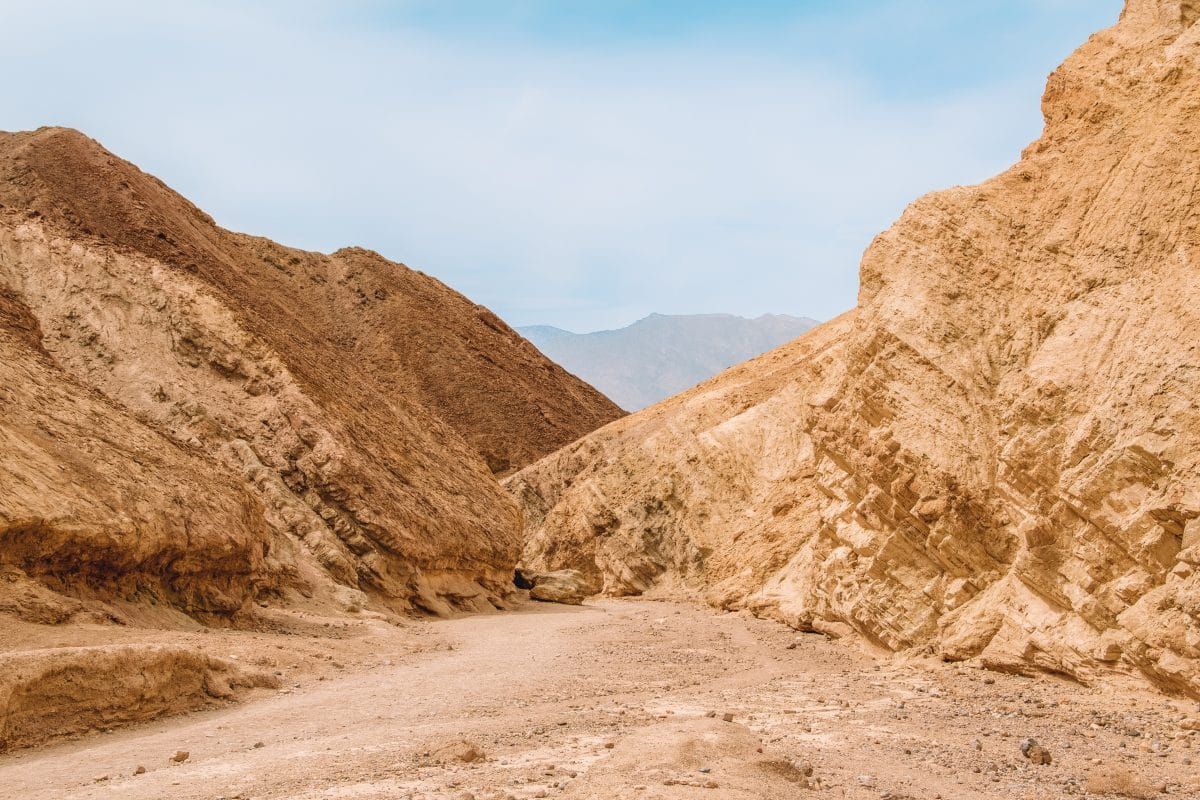
Several scenes in the Star Wars movies, including A New Hope and Return of the Jedi, were filmed in Death Valley National Park.
It all started on Tatooine, which is conveniently located in Death Valley in real life. The little Jawas in the movie run across hills that are just west of Artist’s Drive.
From the Artist’s Palette parking lot, turn the opposite way and start hiking up the hill. This is where students of Death Valley Elementary School once played the Jawas.
That nameless wash where R2D2 was captured is now nicknamed R2’s Arroyo.
Just north of Artist’s Drive, you’ll find Desolation Canyon where all the scenes with the Bantha and its Tusken Raiders were filmed.
The film crew brought a real elephant from San Francisco and clad her in a Bantha costume for the scenes, which she understandably didn’t like.
You can also take a drive through Twenty Mule Team Canyon to the location where Jabba the Hut had his palace.
If you download the NPS app, you’ll find a lot of descriptions of Star Wars filming locations in Death Valley National Park, along with specific routes.
Star Gaze at the Dark Night Sky
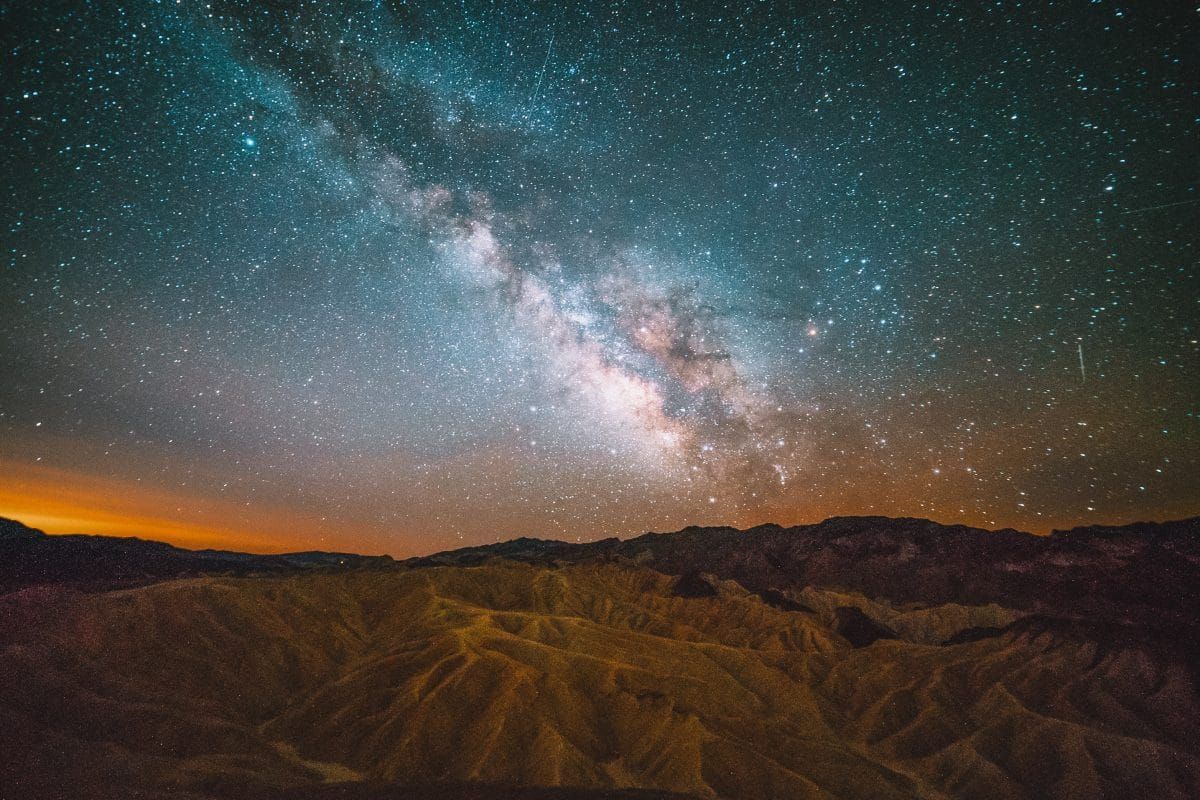
Have you ever wondered about things to do in Death Valley at night? This national park is known for its dark skies and is the country’s third International Dark Sky Park.
It’s well worth staying one or more nights in Death Valley just to have a look at the stars.
From Death Valley, you can usually see the Milky Way in its full glory. The stars are especially visible when the moon isn’t too bright.
And thanks to the dry desert climate, clouds hardly ever ruin the view.
Local tip: if you want to keep your night vision and need light for walking, use a red light. It doesn’t make the pupils contract and you won’t have to wait several minutes for your night vision to return.
Alternatively, if you don’t feel comfortable being in the desert by yourself at night, no problem.
You can book a night sky tour with experienced guides who will explain everything from the moon to the most remote stars.
Play Golf at the Lowest Golf Course on Earth
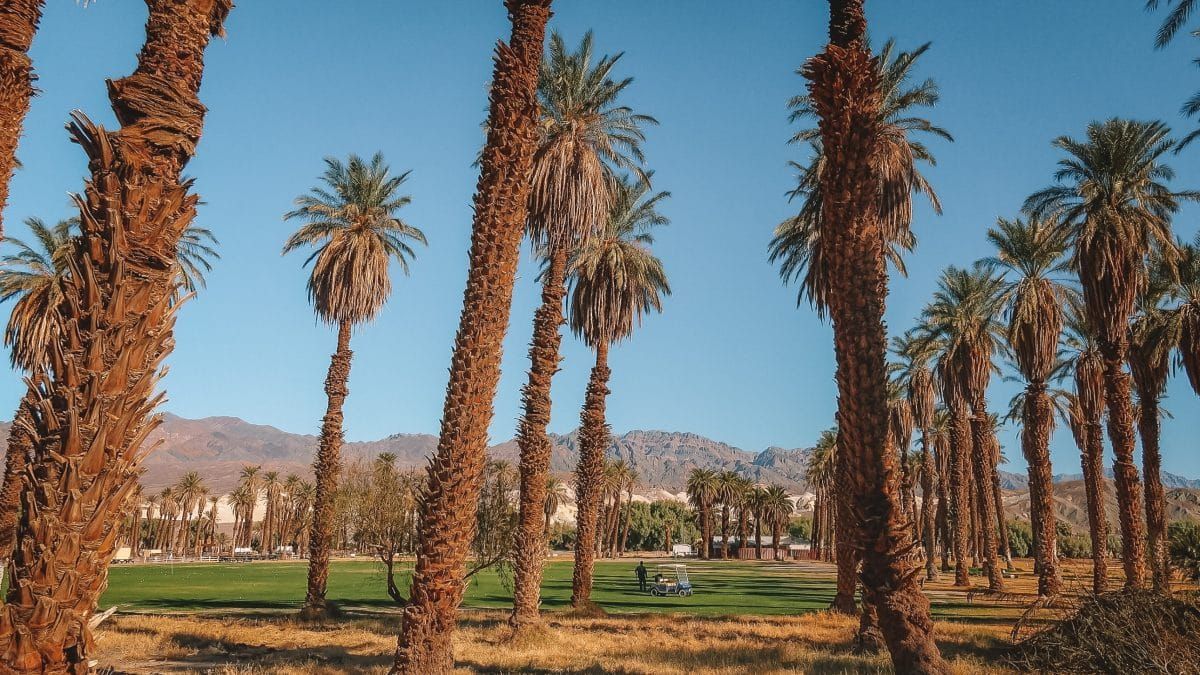
Furnace Creek is not just an oasis in the desert, it’s also an oasis with a golf course.
It even boasts the typical lush golf course lawn that gets manicured to perfection (probably using a ton of water in the process).
I’ve visited Death Valley a lot, yet it always surprises me to see so much greenery here.
Even better, it’s located at 214 feet below sea level, making it the lowest golf course in the world.
Learn More About the Park by Earning a Junior Ranger Badge
The Junior Ranger program of the National Park Service was originally designed for kids. However, throughout the years it has become more and more popular with adults as well.
So whether you’re traveling with kids or not, stop by the visitor center and ask for the Junior Ranger book at the front desk.
The ranger or volunteer in charge will give you a booklet and tell you to complete all the activities in it, like an educational scavenger hunt!
This book is a great companion for your visit because it makes you think more in-depth about the surreal landscape, dunes, salt, the unforgiving desert climate, and more.
When you’re finished, just bring it back to the visitor center or mail it in after your visit. You’ll be rewarded with a Junior Ranger badge and brownie points.
Where to Eat & Drink in Death Valley National Park
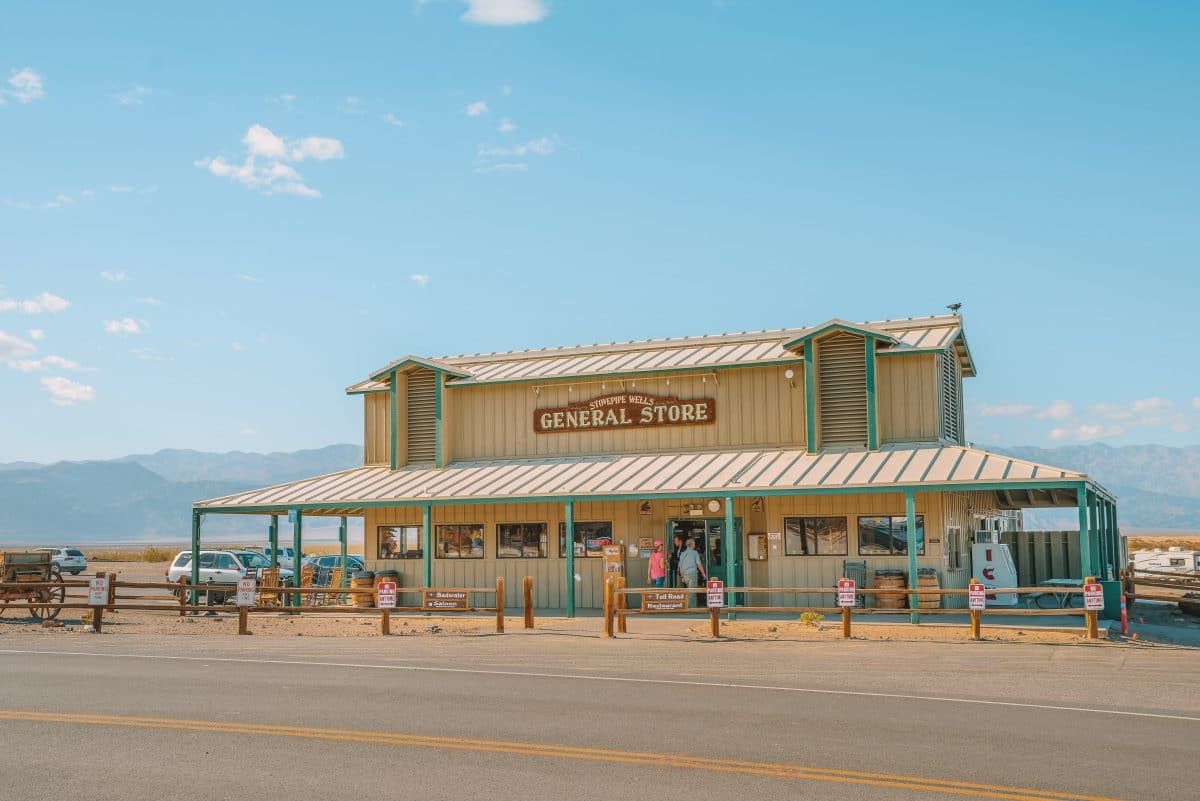
Furnace Creek
- The Inn at Death Valley
- The Ranch 1849 Buffet
- Last Kind Words Saloon
- Coffee and Cream
- General Store
- Visitor Center (they have packaged sandwiches and non-alcoholic drinks)
Timbisha Shoshone Village
Stovepipe Wells
- Badwater Saloon
- Toll Road Restaurant (only open during winter)
- General Store
Panamint Springs
Where to Stay in Death Valley National Park
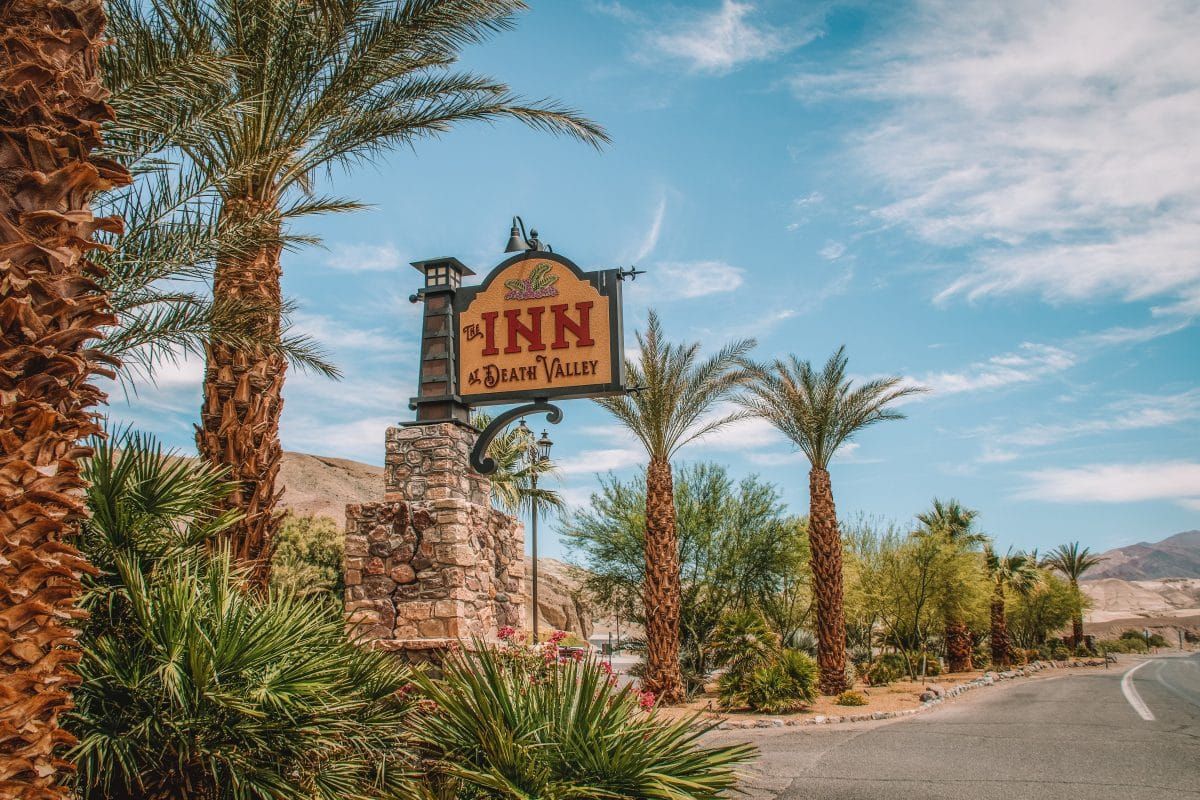
Hotels
Airbnbs
There are no Airbnbs within Death Valley National Park. The nearest communities are all at least a 30-minute drive from any of the places to visit in Death Valley.
However, these are some of my favorite Airbnbs near Death Valley:
- The Bottle Cottage in Tecopa, CA is a cute earth house with a bunch of old bottles built into the walls. These create a mystical look and fill the room with colors when the sun shines through the glass. Tecopa is about halfway between Furnace Creek and Las Vegas.
- At the Feather Hut, you can stay in a Tiny House in Beatty, NV. Even though the whole house is the size of a room, it has everything, including the kitchen sink.
- The Camp Container in Pahrump sounds more rugged than it is. While the fully-equipped tiny house is located inside a shipping container, there is outdoor furniture and a fire pit as well. The highlight is the extra outdoor bed for stargazing.
Campgrounds
Camping in RVs or tents is the most versatile option for staying in Death Valley National Park.
There are several campgrounds to choose from, including:
- Furnace Creek – open all year but reservations are recommended during the winter.
- Sunset – at Furnace Creek, open late fall to spring, no reservations.
- Texas Springs – at Furnace Creek, open late fall to spring, no reservations.
- Stovepipe Wells: open late fall to spring, no reservations.
- Mesquite Spring: open all year, no reservations.
- Emigrant: primitive campground near Stovepipe Wells, open year-round, no reservations.
- Wildrose: primitive campground, open all year, but roads can be snowy and icy in winter, no vehicles longer than 25 ft are allowed.
- Thorndike: primitive campground, open in summer but a high clearance vehicle is needed.
- Mahogany Flat: primitive campground, open in summer but a high clearance vehicle is needed.
- Panamint Springs: privately owned campground, open year-round, reservations are recommended during peak season.
Best Time to Visit Death Valley National Park
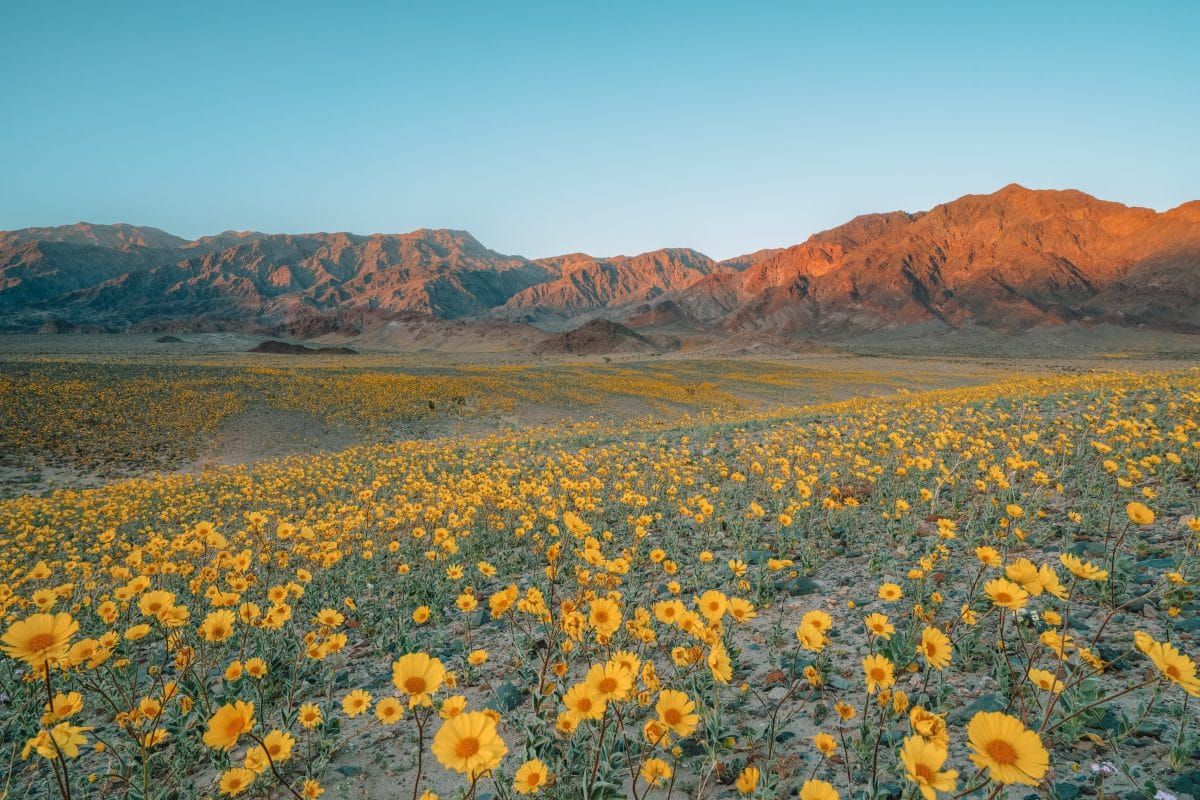
November through April is the best season to visit Death Valley Park, although some people choose to visit Death Valley during summer to experience the surreal heat.
In general, if you want to see more Death Valley attractions than the thermometer at Furnace Creek and the interior of your car, you should not visit during summer.
Most of the fun things to do in Death Valley are in the hot areas just above or below sea level, so summer is probably not the best time to visit if it’s your first time at the park.
How to Get Around Death Valley National Park
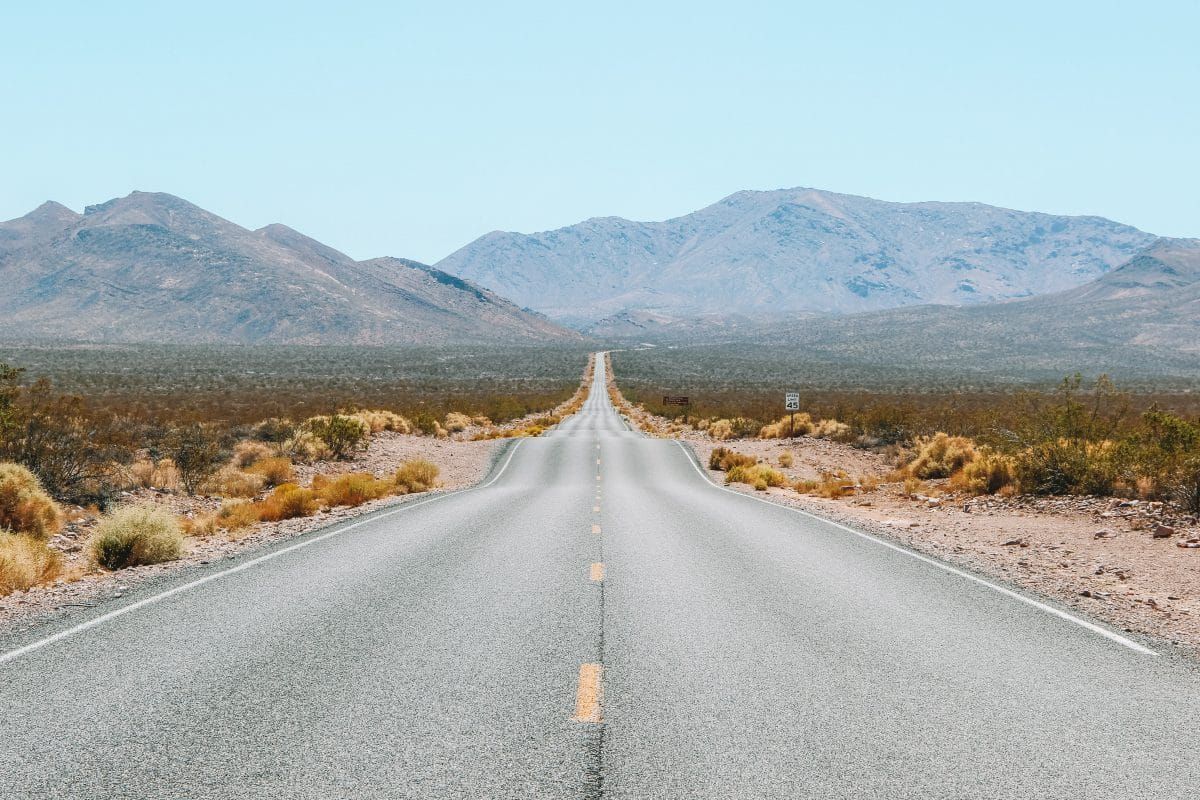
Driving
Death Valley National Park is a very remote destination at just under five hours from Los Angeles or a little over two hours from Las Vegas.
This means that it’s one of the national parks that requires you to have your own vehicle to get around. There’s not even public transit to get to the park.
Guided Tours
Otherwise, if you’d like to do some Death Valley sightseeing without needing to do all the driving yourself, you can easily book one of many tours starting in Las Vegas.
Tips for Visiting Death Valley National Park
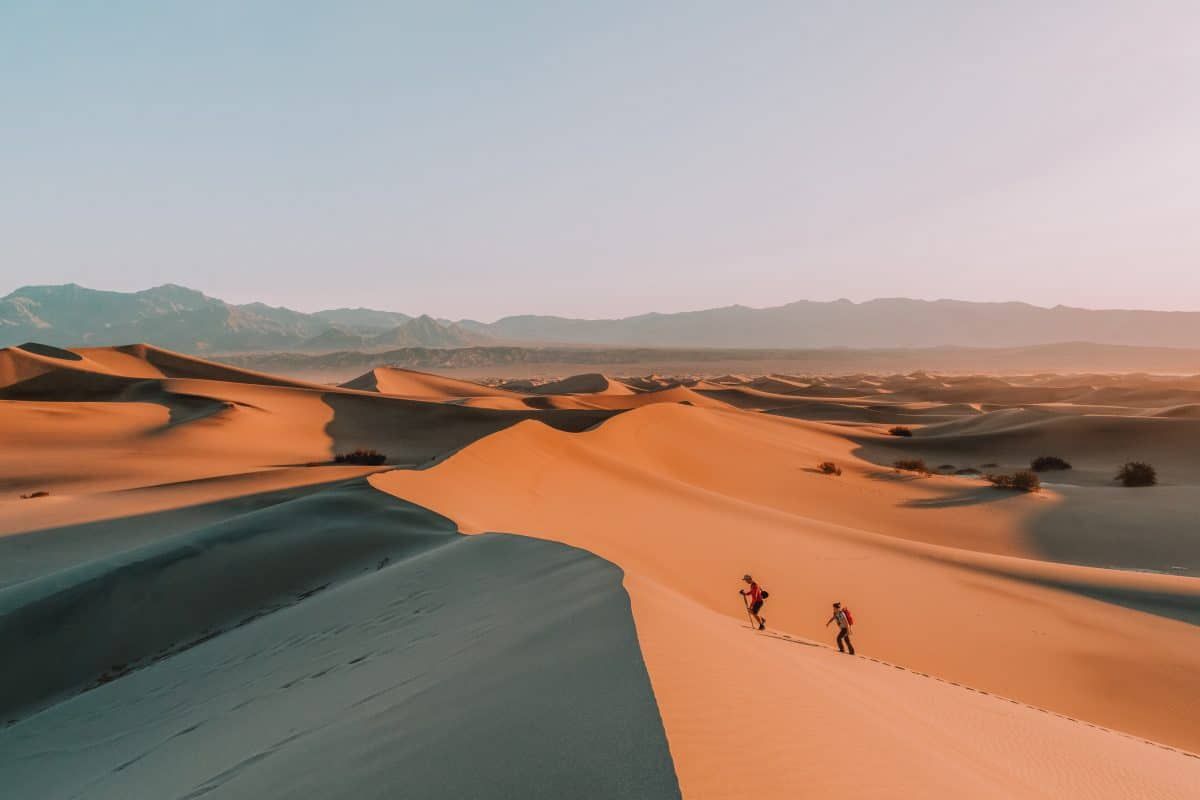
- Dogs are not allowed off-pavement – Dogs are banned from all hiking trails and other attractions like the salt flats in Badwater Basin at Death Valley National Park. But honestly, this national park is not a good place for a hike with Fido anyway. Heat and dry climates are challenging for little bodies, and the sharp rocks and salt can hurt their paws.
- When it’s hot, go early or late – Even in winter, it can get pretty hot here. If you want to enjoy your Death Valley hikes, it’s best to go in the morning before the sun reaches its peak or just before sunset.
- Cell service? What is that? – Most of Death Valley National Park doesn’t have any cell service. Depending on your provider, you might have some luck at Furnace Creek, Stovepipe Wells, and Panamint Springs. However, some carriers are known to have zero reception at the park.
- Wear closed-toe shoes – Trust me, I’ve had cacti stab my toes before. You don’t want to feel that. Always wear comfortable closed-toe shoes when you’re walking around the park to keep your feet protected from the extreme desert landscape.
- How good is your car? – In summer, it’s not just humans who suffer from the heat. Cars do too. Keep in mind that all roads leading out of the park climb at least 3,000 feet uphill. Many radiators die a steamy death there.
- Do you have enough gas? – There are only three gas stations in Death Valley National Park. One each in Furnace Creek, in Stovepipe Wells, and Panamint Springs. This is not the right place to wait for the light by the gauge to come on.
What to Pack for Death Valley National Park
Water, water, and more water! You’re in the driest of all the US national parks. The humidity can be as low as 2% here.
This means that you don’t feel it when you get sweaty because the sweat immediately evaporates off your skin. In other words: you don’t notice when you’re dehydrating.
It’s best to bring a large container with several gallons of water in the car and then bottles or bladders for hiking. The National Park Service recommends a half gallon for a short winter hike to several gallons for long hikes and warmer seasons.
Another thing you don’t want to be missing on your trip to Death Valley is sun protection. Wear a hat with a wide brim and use sunscreen on any exposed skin. This is the desert where cloudy days are a rare occasion.
Also, don’t forget to bring your national park passport, just for fun!
FAQs About Death Valley National Park
How Many Days Should I Spend in Death Valley?
In summer, half a day is more than enough to drive to the famous thermometer at the visitor center of Furnace Creek, take a selfie, and then escape before your car’s air conditioning gets overwhelmed.
During the more pleasant times of the year, your Death Valley National Park itinerary should include between two to four days, depending on how many hikes you want to do and attractions you want to see.
What Should I Not Miss at Death Valley National Park?
Badwater Basin, of course. The lowest point of North America is the Death Valley must-see.
What is Death Valley Known For?
- Relentless heat in summer
- Sand dunes
- Star Wars
- Funky rock formations
- Salt flats
- Stargazing
Practical Info
Entrance Fee: $30, valid for seven days and payable at self-service kiosks. If you’d like to buy an America the Beautiful Pass for year-long entry to all national parks, you can either do so online or at the visitor center in Furnace Creek.
Death Valley National Park Hours & Phone Numbers:
- Furnace Creek Visitor Center: Open 8 AM to 5 PM every day.
- Phone: (760) 786-3200
ABOUT THE AUTHOR

Sabine McCarthy
Get your FREE California Travel Planner – including printable checklists and my favorite two-week itinerary for the state.
Looking for more California parks travel inspiration? Check out my related posts below!
Palm Springs to Joshua Tree National Park
Epic California National Parks Road Trip
100+ Things to do in California
California State Parks List (Every Park Organized by County)
Things to do in Yosemite National Park
Pin this image for future reference

